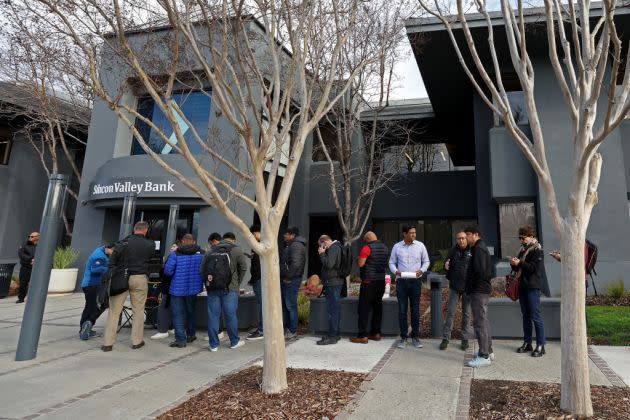Silicon Valley Bank’s Chilling Effect on Fashion

If the ground feels just a little shakier underfoot, call it The Silicon Valley Bank Effect.
Even though the U.S. federal government stepped in to avoid a broader financial system meltdown — guaranteeing depositors would get access to all of their funds after a run on the start-up friendly bank — new troubles abound for fashion.
More from WWD
It’s a bit of bank crisis that has the potential to hurt both sides of the fashion business, with companies racing to double check their finances and consumers potentially becoming more cautious.
“Of course everyone is worried,” said Gary Wassner, chief executive officer of Hilldun Corp., which helps finance many designers. “When things like this occur, it creates more uncertainty in an already uncertain environment. Many worry what, if any, repercussions could follow. Instability creates doubt and concern.
“When it touches the banking system, it creates concern about the foundations that most people take for granted, so the apprehensions are fundamental,” Wassner said. “I have had many clients ask me what this means and what it might foreshadow.”
Wassner described it as “just another bump in the road” — but the question lingering at the start of the week was, just how bumpy could the road ahead get?
President Joe Biden sought to assuage fears on Monday with a short address before the market opened.
“The banking system is safe,” Biden said from the White House. “Your deposits will be there when you need them. Small businesses across the country that had deposit accounts at these banks can breathe easier knowing they’ll be able to pay their workers and pay their bills.”
He also said the management of SVB and Signature Bank, which was also taken over by the government after getting tripped up by crypto currencies, would be fired and that investors who took a risk on the banks would lose their money.
“That’s how capitalism works,” he said.
Still, investors in retail weren’t taking any chances on Wall Street.
While the Dow Jones Industrial Average on Monday slipped a modest 0.3 percent, or 90.50 points, to close at 31,819.14, fashion was hit particularly hard. Among the decliners were Kohl’s Corp., down 8.1 percent to $22.82; Allbirds Inc., 8 percent to $1.15; Under Armour Inc., 7.5 percent to $7.26; Nordstrom Inc., 7.5 percent to $16.87; G-III Apparel Group, 5.2 percent to $15.02, and Abercrombie & Fitch Co., 5 percent to $25.62.
While the worry over the weekend was that the start-ups that stored their payrolls in SVB would suddenly not be able to pay their employees — a concern the Biden administration has covered now — there was some other fallout.
The already struggling Stitch Fix Inc., for instance, found its financial cushion diminished, noting that it does not expect to have access to SVB’s $40 million share of a $100 million line of revolving credit, according to a filing with the Securities and Exchange Commision.
Stitch Fix doesn’t plan on drawing from that line of credit and said it has enough availability to cover any working capital needs.
That was enough to satisfy investors, who sent shares of Stitch Fix up 4.4 percent to $4.96 on Monday.
But the styling service — and the rest of retail — also now find themselves selling to a rattled customer base, who are tired of crises and already strained by high inflation.
“Consumers do not like risk, they do not like volatility,” said David Bassuk, global leader of the retail practice at AlixPartners. “The [stock] markets know how to read that and the markets are turbulent because of that.
“What we’ve learned from the past is that when there is a crisis of this nature, the consumers really pull back, they’re extremely responsive to this,” Bassuk said. “The contractions around spending are real and they’re meaningful and the consumer, their psyche just takes over.”
But Bassuk, relying on a study of the last six big crises going back to the 1987 stock crash, said consumers pull back quickly, but also rebound just as fast.
“We need to be prepared for that,” he said.
The hope is that the trouble passes quickly.
Consultant Hemal Nagarsheth, a partner in the financial services practice of Kearney, said SVB was “not representative of a lot of other banks” and that there was no sense of “contagion,” where its failure would spread widely through the financial system.
“They were pretty different in a lot of ways,” Nagarsheth said. “They were a high-flying bank, some folks sort of contend they were always attracting money that may not have been very stable to begin with.”
Even so, he said it was a good time for companies to take a close look at just what kind of risk they — and their partners — are taking on.
That goes double for areas such as crypto, which many fashion companies have been dabbling in.
“It doesn’t hurt to say, ‘Let’s take a second look at how do I manage risk for all the partners and vendors that I use?’” Nagarsheth said. “What have you done to make sure that you’re all aware of who you’re depending on and what is your risk, especially if look at anything that’s nontraditional? Crypto is just one example.”
So as fashion’s accounting departments pore over their books just in case, the rest of the industry can cross their fingers for now.
Best of WWD
